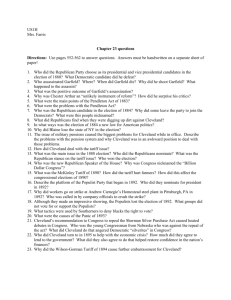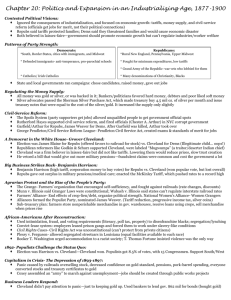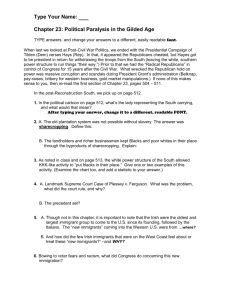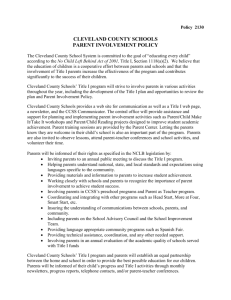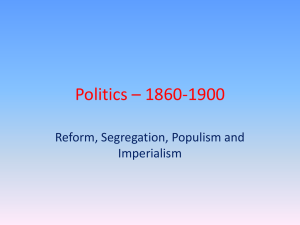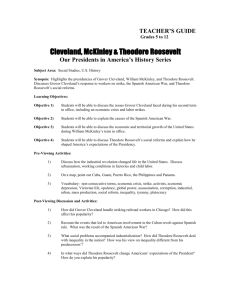Rise of Industrial America Timeline 1877-1900
advertisement
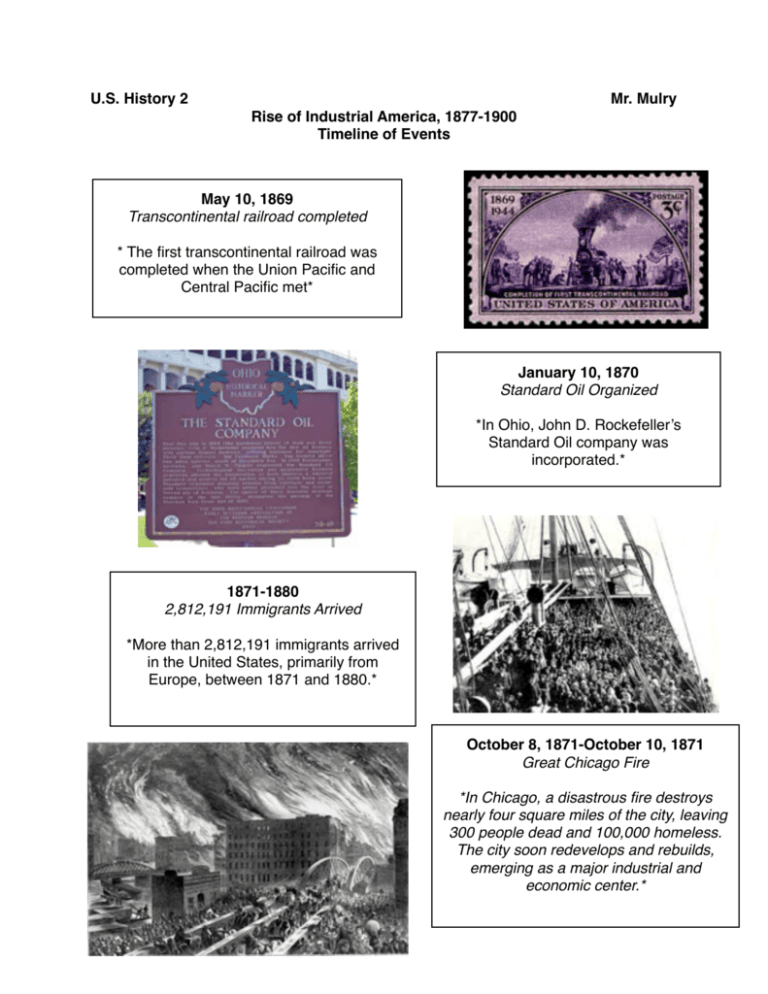
U.S. History 2 Mr. Mulry Rise of Industrial America, 1877-1900 Timeline of Events May 10, 1869 Transcontinental railroad completed * The first transcontinental railroad was completed when the Union Pacific and Central Pacific met* January 10, 1870 Standard Oil Organized *In Ohio, John D. Rockefeller’s Standard Oil company was incorporated.* 1871-1880 2,812,191 Immigrants Arrived *More than 2,812,191 immigrants arrived in the United States, primarily from Europe, between 1871 and 1880.* October 8, 1871-October 10, 1871 Great Chicago Fire *In Chicago, a disastrous fire destroys nearly four square miles of the city, leaving 300 people dead and 100,000 homeless. The city soon redevelops and rebuilds, emerging as a major industrial and economic center.* March 1, 1872 Yellowstone National Park Act *The Yellowstone National Park Act set an area of the Wyoming and Montana territories aside as “the people’s pleasuring ground.* September 4, 1872 Credit Mobilier Scandal 1875 Nation’s largest steel plant opened. *Andrew Carnegie opened the nation’s largest steel plant just outside of Pittsburgh, Pennsylvania.* *News broke that members of Congress had been involved in rail industry corruption. The Union Pacific Railroad company had been hired to build part of the transcontinental railway. Instead of hiring outside contractors to complete the construction, however, Union Pacific vice president Thomas Durant and Union Pacific’s other largest stockholders organized their own construction company—Crédit Mobilier —and awarded the UP building contract to themselves. Durant and other Crédit Mobilier executives reaped major profits for themselves from the construction, which was financed largely by government subsidies, overcharging for the cost of construction and nearly bankrupting Union Pacific. Durant also distributed Crédit Mobilier stock to several members of Congress who had been influential in railroad legislation. Union Pacific came to be worth almost nothing, and while Durant and other major UP stockholders had made themselves rich, many others were left with worthless securities. After Durant’s scheme came to light, eleven members of Congress were accused of accepting shares of Crédit Mobilier's stock and contributing to the corruption of the rail industry. May 10, 1875 Whiskey Ring Scandal *In St. Louis, a ring of distillers and federal officials were discovered to have colluded in tax evasion. Those indicted in the scandal included many of President Grant’s appointees.* March 7, 1876 Telephone Patented *Inventor Alexander Graham Bell patented the telephone.* June 25, 1876 Battle of Little Bighorn *In the war against western Sioux, General George Custer and more than two hundred of his men died along Montana’s Little Bighorn River at the hands of Sioux and Cheyenne warriors.* 1877 Nez Perce War *Hostilities between settlers and the Nez Perce Indians became violent in June 1877. For the next four months, the Nez Perce were pursued by the US Army, and the two sides clashed across Montana and Idaho. In October, led by Chief Joseph, the Indians surrendered. Though promised a safe return to their Oregon homeland, the Nez Perce were relocated to Kansas and Oklahoma.* March 2, 1877 Compromise of 1877 *Rutherford B. Hayes was declared winner of a presidential election fraught with accusations and arguments. The final outcome of the election hinged on the disputed results in four states—Florida, Louisiana, Oregon, and South Carolina—which prevented either candidate from securing a majority of electoral votes. At a meeting in February 1877, Democratic leaders accepted Hayes’s election in exchange for Republican promises to withdraw federal troops from the South, provide federal funding for internal improvements in the South, and name a prominent southerner to the president’s Cabinet. When the federal troops were withdrawn, the Republican governments in Florida, Louisiana, and South Carolina collapsed, bringing Reconstruction to a formal end. Under the Compromise of 1877, the national government could no longer intervene in state affairs. This permitted the imposition of racial segregation and the disfranchisement of black voters.* July 14, 1877 Great Railway Strike of 1877 Railroad workers in Martinsburg, West Virginia, initiated a strike to protest working conditions and wages. The strike spread and lasted more than a month, sparking violence and damaging the economy before being put down by federal troops. 1878 Bannock War *Conflict broke out when the United States failed to honor its 1868 treaty promising to assign prairie lands to the Bannock Indians. Pushed west by white incursion and suffering from starvation, the Bannock and Northern Shoshone tribes raided white settlements for food. The Army put down the raids, and the Bannock surrendered and were returned to their reservation near Fort Hall, Idaho.* February 28, 1878 Bland-Allison Act *In an attempt to counteract deflation, and over President Hayes’ veto, Congress passed the Bland-Allison Act, which authorized a limited amount of silver dollars.* 1879 Progress and Poverty *Henry George’s Progress and Poverty, on the cycle of industrial economy, was published.* 1880-1889 Harsh weather affected livestock in the West *Drought and harsh winters during the 1880s devastated cattle herds throughout the West.* November 2, 1880 James Garfield elected president *James Garfield was elected the twentieth president of the United States over Democrat W.S. Hancock.* July 2, 1881-September 19, 1881 James Garfield Assassinated *President James Garfield was shot on July 2, 1881, by Charles J. Guiteau. Garfield died two months later on September 19, 1881.* September 19, 1881 Chester Arthur Became President *Chester A. Arthur became president upon James Garfield’s death.* May 8, 1882 Chinese Exclusion Act *The Chinese Exclusion Act was the nation’s first law to ban immigration by race or nationality. The act, which was renewed and enforced until 1943, banned Chinese immigration for ten years and prohibited Chinese from becoming citizens.* August 5, 1882 Standard Oil Trust Organized *John D. Rockefeller created Standard Oil Trust by trading stockholders’ shares for trust certificates. The trust was designed to allow Rockefeller and other Standard Oil stockholders to get around state laws prohibiting one company from owning stock in another.* January 16, 1883 Pendleton Act *The Pendleton Civil Service Reform Act was passed. In an attempt to curb corruption and patronage, the act introduced federal exams and merit requirements for the hiring of civil servants.* September 8, 1883 Northern Pacific Railroad Completed *The completion of the Northern Pacific railroad was celebrated with a “golden spike” ceremony at Gold Creek, Montana.* November 4, 1884 Grover Cleveland Elected President *The presidential campaign of 1884 was one of the most memorable in American history. The Republican nominee, James G. Blaine of Maine, was nicknamed the “plumed knight,” but disgruntled Republican reformers regarded him as a symbol of corruption. These liberal Republicans indicated to Democratic leaders that they would bolt their own party and support a Democrat, provided he was a decent and honorable man. Grover Cleveland seemed to meet these qualifications. He had started his career as sheriff of Erie County where he personally hanged two murderers to spare the sensibilities of his subordinates. He had been known as the “veto” mayor of Buffalo for rejecting political graft, and as governor of New York, he had repudiated Tammany Hall. Some Republicans attacked Cleveland for avoiding service during the Civil War; he had hired a substitute to take his place. Democrats, in turn, claimed that Blaine had sold his influence in Congress to business interests. Then a Buffalo newspaper dealt Cleveland a devastating blow by revealing that he had fathered a child out of wedlock. Even worse, Republicans charged, Cleveland had placed the child in an orphanage and the mother in an insane asylum. These attacks failed to ignite much public indignation against Cleveland, however, and in the election, white southerners, Irish Americans, and German American voters turned out in record numbers. Grover Cleveland was elected the twenty-second president of the United States, making him the first Democrat elected to the office since Buchanan.* May 4, 1886 Haymarket Square Riot In Chicago’s Haymarket Square, anarchists gathered to protest the police killing of labor strikers. When police attempted to end the demonstration, a bomb was thrown and exploded in the crowd. In the ensuing clash, police fired into the crowd and eight policemen and several protestors were killed and many more injured. December 8, 1886 American Federation of Labor Founded *The American Federation of Labor was formed by trade unions to organize skilled workers, with Samuel Gompers as its first president.* 1887 Alternating Current Motor Invented *Nikola Tesla invented the alternating current (AC) motor, making it possible to transmit electricity over great distances.* February 4, 1887 Interstate Commerce Act *Under pressure from small businesses and farmers, Congress passed the Interstate Commerce Act creating the Interstate Commerce Commission, the first federal regulatory commission.* November 6, 1888 Benjamin Harrison Elected President *In office, Grover Cleveland had pleased conservatives by advocating sound money and reduction of inflation, curbing party patronage, and vetoing government pensions. But he alienated business and labor interests by proposing a lower tariff and was defeated in the presidential race of 1888 —winning the popular vote but losing the electoral vote to Republican Benjamin Harrison.* 1890 How the Other Half Lives Published *Jacob Riis’s book How the Other Half Lives documented living conditions among immigrants in New York City 1890 Immigrants at 14.7% of Population *Foreign-born immigrants made up 14.7% of the population, up from 9.7% in 1850.* July 2, 1890 Sherman Anti-Trust Act *Congress passed the Sherman Anti-Trust Act to prohibit trusts and prevent monopolies.* October 1, 1890 McKinley Tariff December 29, 1890 Wounded Knee *US Troops slaughtered about 200 Sioux, many of whom were women and children, at Wounded Knee Creek, South Dakota.* *After 1887, the tariff became the central issue in American politics. Democrats, led by Grover Cleveland, charged that the tariff raised prices, enriched the wealthy, and fostered inefficiency. Republicans argued that tariffs promoted infant industries, protected established industries, raised workers’ wages and protected them against low-wage competition, and fostered a rich home market for farm goods. In fact, the tariff was not especially important for manufacturers. European manufacturers could not compete with the American advantages of large efficient factories, vast internal markets, ample raw materials, sophisticated advertising, and a highly efficient distribution system. By 1885, the United States had become the world’s low-cost, high-volume manufacturer. In October 1890, the McKinley Tariff was passed. Named for one of its authors—future president William McKinley—it increased tariff rates, making it the highest protective tariff ever adopted. It also provided for reciprocal trade agreements. The actual beneficiaries from a high tariff were sugar growers and producers of wool, leather hides, coal, timber, and iron ore. The McKinley Tariff was unpopular with American consumers and labor and inflicted substantial political damage on the Republican Party in the election of 1892.* January 17, 1891 Overthrow of Hawaii *In Hawaii, foreign entrepreneurs, fearing Queen Lili’uokalani’s plan to restore the kingdom to indigenous Hawaiians, staged a revolt by declaring Hawaii a republic and seeking annexation by the US. American Marines invaded, Lili’uokalani surrendered, and the US minister to Hawaii declared it a protectorate of the United States.* January 5, 1892 Ellis Island Opened *Fifteen-year-old Annie Moore of Ireland became the first immigrant to pass through Ellis Island.* June 30, 1892 Homestead Steel Strike *In response to falling steel prices, Henry C. Frick, the general manager of Andrew Carnegie’s steel plant in Homestead, Pennsylvania, cut wages and attempted to quash the workers’ Amalgamated Association of Iron and Steel Workers. The workers protested, and Frick closed the mills and refused to negotiate with the union, declaring that he would only deal with individual workers. The workers tried to appeal to Carnegie, who had defended unionization, but Carnegie made himself unavailable. The workers voted to strike, and Frick hired a private army to disperse the strikers. The ensuing violent conflict lasted fourteen hours and was put down by the Pennsylvania state militia. The strike’s leaders were blacklisted, and Carnegie’s company successfully broke unions in Homestead and throughout Pennsylvania steel country. November 8, 1892 Grover Cleveland Elected President Again *Grover Cleveland was elected the twenty-fourth president of the United States thanks in part to a third party movement—the Populists—that siphoned off some of the strength of the Republican Party, and by a vigorous campaign against the extravagance of the Republican “Billion Dollar Congress.” But his second term would be ruined by the economic depression of the mid-1890s, the worst economic crisis that the country had ever seen. Insisting on sound money, in his second term Cleveland would seek to keep the country on the gold standard and convince Congress to enact an income tax (which was declared unconstitutional by the Supreme Court). By 1896, Cleveland’s policies were repudiated by his own party.* January 6, 1893 Great Northern Railway Completed *In scenic, Washington, the Great Northern Railway, which crossed the Cascades and reached Seattle, was completed.* 1893 Panic of 1893 The stock market crashed, prompting the Panic of 1893 and leading to the bankrupting of the United States Treasury. The already weakened economy collapsed as people withdrew deposited funds and banks failed. Exports also declined and unemployment grew July 12, 1893 Frederick Jackson Turner’s “Frontier Thesis” *Historian Frederick Jackson Turner presented his “frontier thesis” in an address in Chicago, the site of the 1893 World’s Columbian Exposition. Turner pointed to expansion as the most important factor in American history. He claimed that “the existence of an area of free land, its continuous recession, and the advance of American settlement westward explain American development.” In 1890, however, the Census Bureau stated that all the land within the United States was claimed, and there was no longer a frontier. “Now, four centuries from the discovery of America, at the end of a hundred years of life under the Constitution, the frontier has gone, and with its going has closed the first period of American history,” Turner asserted, questioning how American culture and history would develop and whether Americans would retain “that coarseness and strength combined with acuteness and acquisitiveness that dominant individualism” bred by expansion now that the frontier was closed.* May 18, 1896 Plessy v. Ferguson *In Plessy v. Ferguson, the Supreme Court ruled a Louisiana law segregating train cars was constitutional based on the doctrine of “separate but equal.”* July 11, 1894 Pullman Steel Strike *Pullman Palace Car Company workers initiated a boycott of Pullman train cars through the American Railway Union. The boycott, observed by 150,000 members of the American Railway Union, stopped rail traffic in and out of Chicago and affected rail traffic across the country. The US Attorney General issued an injunction against the striking workers, and President Grover Cleveland sent federal forces to protect trains being run by non-union strikebreakers. Pro-union mobs destroyed trains and buildings, leading to the jailing of union and strike leaders and the end of the American Railway Union.* November 3, 1896 William McKinley Elected President *In the presidential election of 1896, Republican William McKinley defeated populist Democrat William Jennings Bryan to win the executive office.* April 11, 1898-December 10, 1898 Spanish-American War *The debate over America’s global role intensified when Cubans began to fight for their independence from Spain in 1895. Americans were sympathetic to Cuba’s struggle for independence, but were divided about how to help. President William McKinley was deeply ambivalent about war against Spain. Ultimately, however, the pressure of public opinion forced McKinley into the war that made the United States an international power. Newspaper publishers like William Randolph Hearst and Joseph Pulitzer worked up war fever among the public with reports of Spanish atrocities against Cuban rebels. Then, Hearst’s New York Journal published a leaked letter in which the chief Spanish diplomat in Washington described President McKinley as “weak” and a “petty politician.” Hearst publicized the letter under the screaming headline “WORST INSULT TO THE UNITED STATES IN ITS HISTORY.” Days later an explosion sank the USS Maine in Havana harbor. A naval court of inquiry blamed the explosion on a mine, further inflaming public sentiment against Spain. After ten days of debate, Congress declared war, but only after adopting the Teller Amendment, in which the United States made it clear that it did not harbor imperialist ambitions. The amendment announced that the United States would not acquire Cuba. But after the United States defeated Spain, it set up a military government on Cuba and made the soldiers’ withdrawal contingent on the Cubans accepting the Platt Amendment, which gave the United States the right to intervene in Cuba to protect “life, property, and individual liberties.” The 144-day war also resulted in the United States taking control of the Philippines, Puerto Rico, and Guam.* July 7, 1898 Annexation of Hawaii *A joint resolution of Congress approved the annexation of Hawaii.* December 10, 1898 Annexation of Philippines, Puerto Rico, and Guam *In the 1898 Treaty of Paris, which ended the SpanishAmerican War, Spain ceded the Philippines, Puerto Rico, and Guam to the United States.* 1899-1902 Philippine-American War The Philippine-American War, fought from February 1899 to July 1902, claimed 250,000 lives and helped establish the United States as a power in the Pacific. On June 12, 1898, a young Filipino general, Emilio Aguinaldo, proclaimed Philippine independence and established Asia’s first republic. He had hoped that the Philippines would become a US protectorate, but pressure on President William McKinley to annex the Philippines was intense. On February 4, 1899, fighting erupted between American and Filipino soldiers leaving fifty-nine Americans and approximately 3,000 Filipinos dead. American commanders hoped for a short conflict, but in the end more than 70,000 would fight in the archipelago. Unable to defeat the United States in conventional warfare, the Filipinos adopted guerrilla tactics. The war was officially declared over in July 1902, but fighting continued for several years. The Philippine War convinced the United States not to seize further overseas territory. More than 4,000 American soldiers and about 20,000 Filipino fighters died. An estimated 200,000 Filipino civilians died during the war, mainly of disease or hunger. Reports of American atrocities led the United States to turn internal control over to the Philippines to Filipinos in 1907 and to pledge to grant the archipelago independence in 1916. The 1916 Jones Act, however, delayed Philippine independence until a "stable government" was established. US leaders tried to transform the country into a showcase of Americanstyle democracy in Asia, but there was a strong undercurrent of condescension. US President William Howard Taft, who had served as governor-general of the Philippines, called the Filipinos “our little brown brothers.” The Philippines were finally granted independence in 1946. March 14, 1900 Gold Standard Act *Congress passed the Gold Standard Act, making gold the sole monetary standard for US currency.* November 6, 1900 McKinley Re-Elected With Theodore Roosevelt as his running mate, William McKinley again beat out William Jennings Bryan to win re-election to the presidency. April 1, 1901 Formation of U.S. Steel John Pierpont Morgan merged several of Andrew Carnegie’s companies to form US Steel. September 6, 1901 Assassination of William McKinley President William McKinley was shot twice by Leon Czolgosz, the anarchist son of Polish immigrants. McKinley died eight days later on September 14. He was succeeded by Vice President Theodore Roosevelt.
